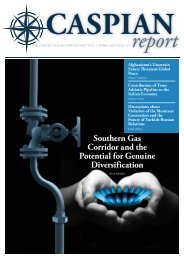Create successful ePaper yourself
Turn your PDF publications into a flip-book with our unique Google optimized e-Paper software.
FATIH MACIT, HOLLY REHM<br />
18<br />
kets, particularly after the Fukushima<br />
nuclear plant accident. The European<br />
Union has been trying to reduce<br />
dependence on Russian gas, and tensions<br />
in Ukraine have increased the<br />
urgency of this issue. In this respect,<br />
more LNG exports, potentially from<br />
United States as well, could provide<br />
a remedy. However, recent developments<br />
show that pipeline trade will<br />
continue to play a major role in European<br />
markets and will increase the<br />
competition for U.S. LNG. The Southern<br />
Gas Corridor project, proposed<br />
in 1990s, is now becoming a reality<br />
with the development of Trans Anatolian<br />
Natural Gas Pipeline (TANAP)<br />
project between Turkey and Azerbaijan.<br />
The first gas flows to European<br />
markets through TANAP will happen<br />
by the end of 2018, at 10 bcm a year.<br />
By the mid-2020s the amount going<br />
to Europe will increase to 20 bcm.<br />
One could argue that compared to<br />
the Europe’s total natural gas consumption,<br />
this amount is fairly negligible,<br />
and will not play a major role in<br />
European natural gas markets. However,<br />
we should think this 20 bcm as<br />
an initial step in the development<br />
of the Southern Gas Corridor. At the<br />
first stage this corridor will be supported<br />
by Azerbaijani gas, but there<br />
are hopes that it will be fed by additional<br />
sources in the future. Turkmen<br />
gas, Iraqi gas and resources in East<br />
Mediterranean may find their place<br />
in this route, and ten years on, more<br />
than 60 bcm of natural gas could be<br />
transported to European markets via<br />
this pipeline. This additional gas may<br />
increase the competition in the market<br />
and reduce the need for U.S. LNG.<br />
Another important issue relates to<br />
the nature of the natural gas business<br />
in Europe. The North American<br />
natural gas business model is mostly<br />
based on a spot market. By contrast,<br />
European markets are mainly based<br />
on long-term contracts where the<br />
natural gas price is indexed to oil<br />
prices. In a spot market model there<br />
might be large fluctuations in prices<br />
for various reasons; this generates<br />
significant uncertainty, particularly<br />
for the manufacturing industry.<br />
Therefore, European producers<br />
might choose to go with current longterm<br />
contracts that reduce this price<br />
uncertainty instead of opting for LNG<br />
exports from the United States.<br />
Increased pipeline trade may also reduce<br />
the competitiveness of U.S. LNG<br />
exports to Asian markets. In contrast<br />
to European countries, countries in<br />
the Asia-Pacific region are largely<br />
reliant on LNG for their domestic<br />
natural gas demand. For some big<br />
consumers in the region like Japan<br />
and South Korea, LNG is the only<br />
source by which natural gas demand<br />
is met. These countries may remain<br />
major LNG consumers, but other big<br />
consumers are taking initiatives to<br />
increase the consumption of pipeline<br />
gas. China has recently signed<br />
an agreement with Russia that that<br />
involves the purchase of 38 bcm of<br />
natural gas annually. China is already<br />
importing a significant amount of gas<br />
from Turkmenistan via pipeline and<br />
is planning to increase this. Other important<br />
consumers in the region like<br />
India and Pakistan are also working<br />
on pipeline projects that will increase<br />
the gas supply from Turkmenistan.<br />
All these developments indicate that<br />
pipeline trade will play a greater role<br />
in Asian markets. This may in turn<br />
put a downward pressure on LNG<br />
prices and reduce the competitiveness<br />
of large scale U.S. LNG export.<br />
The third barrier to large-scale U.S.<br />
LNG export is related to developments<br />
around renewables and energy<br />
efficiency. This has been an important<br />
issue for Europe in particular<br />
over the last decade. The EU’s natural<br />
gas consumption has remained<br />
almost flat over the last ten years.<br />
The rising share of renewables in total<br />
primary energy consumption and<br />
improvements in energy efficiency










